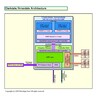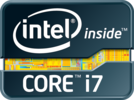Intel Core i7-2640M vs Intel Core i5-430M vs Intel Core i7-2960XM
Intel Core i7-2640M
► remove from comparison
The Intel Core i7-2640M is the fastest dual core processor at the time of introduction in Q3 2011 and successor of the slower clocked i7-2620M. It is based on the Sandy Bridge architecture and offers Hyperthreading to handle 4 threads at once (for a better usage of the pipeline). Compared to the slower Core i5, the i7 offers a larger last level cache of 4MB. The base clock speed is 2.8 GHz but due to Turbo Boost it can reach 3.3 GHz (2 cores active) and 3.5 GHz (1 core active).
Sandy Bridge is the evolutionary successor of the Arrandale architecture. The most noteable improvements are the new 256Bit AVX instructions, the improved Turbo 2.0 and the integration of the graphics card into the 32nm CPU core.
Der i7-2640M offers an integrated graphics card ( Intel HD Graphics 3000) which is clearly faster then the older Intel HD Graphics in the Arrandale CPUs. As the new GPU is included in the CPU, it is also manufactured in 32nm and shares the fast level 3 cache with the CPU cores (using a new ring bus). In the 2620M it is clocked from 650-1300MHz (Turbo Boost), and in the 2640M it should be similar.
Furthermore, an improved dual-channel DDR3 memory controller is included on the CPU die that is used by the CPU and GPU part.
Due to the improved architecture and the new Turbo Boost 2.0, the average performance of the Core i7-2640M is higher than a similar clocked Arrandale Core i7 dual core. The performance should even excel the old high-end quad core models like the Core i7-820QM.
The 35W TDP rating includes the integrated GPU and memory controller.
Intel Core i5-430M
► remove from comparison
The Intel Core i5-430M is a fast middle class dual core CPU for laptops and clocks (due to the Turbo Mode) from 2.26 to 2.53 GHz. Each core is based on the Nehalem (Westmere) micro-architecture. Hyperthreading enables the Dual Core CPU to handle 4 threads at once (for a better usage of the pipeline). Compared to the faster Core i7-620M, the 430M only has 3 MB Level 3 Cache, missing VT-d, Trusted Execution, and AES features and a lower clock speed.
A feature of the new Core i5-430M is the integrated graphics card (called Intel HD Graphics) and memory controller. Both are on a separate die that is still manufactured in 45nm whereas the CPU die is already manufactured in the new 32nm process.
Due to the integrated memory controller, the HyperThreading and Turbo Boost, the Core i5-430M is faster than a similar clocked Core 2 Duo in all (us known) applications and benchmarks. In fact, the 430M even came close to a fast Core 2 Duo T9600 (2.8 GHz) in some benchmarks (e.g. Cinebench 10 Multi Threaded). This means the 430M is a fast middle class - performance CPU and much faster than the top AMD model, the Turion II Ultra M660 (at the time of announcement).
The 32nm cpu cores of the Westmere generation can also process some new instructions to accelerate AES encryptions. Still, these functions are deactivated on the Core i5-430M leading to some performance drawbacks in modern applications that support AES encoding using the new instructions (e.g. the Communications Suite test in the PCMark Vantage boosts up to 70% using AES in the faster Core i5-520M).
The integrated Intel Graphics Media Accelerator HD (GMA HD) graphics card is between 500-766 MHz (Turbo Boost) and is clearly faster than the old GMA 4500MHD. A GeForce 9400M (ION) should still be a faster (especially as Nvidia and ATI cards have a better driver support than Intel up to now). The Turbo Boost can overclock the Intel HD Graphics up to 733 MHz when the cores are not fully used.
The power consumption of 35 Watt TDP (max.) counts for the whole package and therefore it is clearly better than the 35 Watt TDP of the Core 2 Duo T-series (CPU alone).
Intel Core i7-2960XM
► remove from comparison
The Intel Core i7-2960XM is the fastest quad-core processor for laptops in Q3-2011 and successor to the Core i7-2920XM. Due to the Extreme Edition branding, the CPU should be easy to overclock (unlocked multiplicator). It is based on the Sandy Bridge architecture and offers Hyperthreading to handle 8 threads at once (for a better usage of the pipeline). Compared to the previous Clarksdale quad-cores, the i7-2960XM is now manufactured in 32nm, offers an integrated graphics card and AES functions. Compared to the slower clocked 2860QM, the 2960XM is specified with a higher TDP.
Sandy Bridge is the evolutionary successor of the Arrandale architecture. The most noteable improvements are the new 265Bit AVX instructions, the improved Turbo Boost and the integration of the graphics card into the 32nm CPU core. Furthermore, the integrated memory controller was improved and supports up to 8 GB DDR3-1333.
The Core i7-2960XM offers an integrated graphics card (Intel HD Graphics 3000) which proved to be clearly faster than the old Intel HD Graphics in the Arrandale CPUs and on a level with entry level dedicated graphics cards like the GeForce 310M. The HD Graphics 3000 also supports Turbo Boost and clocks between 650 MHz and 1300 MHz in the i7-2920XM (therefore it should be similar or faster in the 2960XM). As the graphics card shares the fast last level cache, the processor is a bit slower with activated GPU.
Due to the high Turbo Boost, large L3 Cache, and Hyperthreading, the performance of the Core i7-2960XM is only slightly lower than the desktop Core i7-2600K. In 2011 it is the fastest mobile processors for laptops. Therefore, the performance should be sufficient for even the most demanding tasks like HD video editing or demanding 3D games.
The high TDP rating of the 2960XM enables the usage of the quad core only in large and heavy laptops (usually 15" and up). Compared to the previous generation (Clarkdale, e.g. Core i7-940XM) of quad-cores, however, the TDP improved, as the integrated GPU is now included.
| Model | Intel Core i7-2640M | Intel Core i5-430M | Intel Core i7-2960XM | ||||||||||||||||||||||||||||||||||||||||||||||||||||||||||||||||||||||||||||||||||||||||||||||||||||||||||||||||||||||||||||||||||||||||||||||||||||||||||||||||||||||||||||||||||||||||||||||||||||
| Series | Intel Core i7 | Intel Core i5 | Intel Core i7 | ||||||||||||||||||||||||||||||||||||||||||||||||||||||||||||||||||||||||||||||||||||||||||||||||||||||||||||||||||||||||||||||||||||||||||||||||||||||||||||||||||||||||||||||||||||||||||||||||||||
| Codename | Sandy Bridge | Arrandale | Sandy Bridge | ||||||||||||||||||||||||||||||||||||||||||||||||||||||||||||||||||||||||||||||||||||||||||||||||||||||||||||||||||||||||||||||||||||||||||||||||||||||||||||||||||||||||||||||||||||||||||||||||||||
| Series: Core i7 Sandy Bridge |
|
|
| ||||||||||||||||||||||||||||||||||||||||||||||||||||||||||||||||||||||||||||||||||||||||||||||||||||||||||||||||||||||||||||||||||||||||||||||||||||||||||||||||||||||||||||||||||||||||||||||||||||
| Clock | 2800 - 3500 MHz | 2260 - 2533 MHz | 2700 - 3700 MHz | ||||||||||||||||||||||||||||||||||||||||||||||||||||||||||||||||||||||||||||||||||||||||||||||||||||||||||||||||||||||||||||||||||||||||||||||||||||||||||||||||||||||||||||||||||||||||||||||||||||
| L1 Cache | 128 KB | 128 KB | 256 KB | ||||||||||||||||||||||||||||||||||||||||||||||||||||||||||||||||||||||||||||||||||||||||||||||||||||||||||||||||||||||||||||||||||||||||||||||||||||||||||||||||||||||||||||||||||||||||||||||||||||
| L2 Cache | 512 KB | 512 KB | 1 MB | ||||||||||||||||||||||||||||||||||||||||||||||||||||||||||||||||||||||||||||||||||||||||||||||||||||||||||||||||||||||||||||||||||||||||||||||||||||||||||||||||||||||||||||||||||||||||||||||||||||
| L3 Cache | 4 MB | 3 MB | 8 MB | ||||||||||||||||||||||||||||||||||||||||||||||||||||||||||||||||||||||||||||||||||||||||||||||||||||||||||||||||||||||||||||||||||||||||||||||||||||||||||||||||||||||||||||||||||||||||||||||||||||
| Cores / Threads | 2 / 4 | 2 / 4 | 4 / 8 | ||||||||||||||||||||||||||||||||||||||||||||||||||||||||||||||||||||||||||||||||||||||||||||||||||||||||||||||||||||||||||||||||||||||||||||||||||||||||||||||||||||||||||||||||||||||||||||||||||||
| TDP | 35 Watt | 35 Watt | 55 Watt | ||||||||||||||||||||||||||||||||||||||||||||||||||||||||||||||||||||||||||||||||||||||||||||||||||||||||||||||||||||||||||||||||||||||||||||||||||||||||||||||||||||||||||||||||||||||||||||||||||||
| Transistors | 624 Million | 177 Million | 995 Million | ||||||||||||||||||||||||||||||||||||||||||||||||||||||||||||||||||||||||||||||||||||||||||||||||||||||||||||||||||||||||||||||||||||||||||||||||||||||||||||||||||||||||||||||||||||||||||||||||||||
| Technology | 32 nm | 32 nm | 32 nm | ||||||||||||||||||||||||||||||||||||||||||||||||||||||||||||||||||||||||||||||||||||||||||||||||||||||||||||||||||||||||||||||||||||||||||||||||||||||||||||||||||||||||||||||||||||||||||||||||||||
| Die Size | 149 mm2 | 144 mm2 | 216 mm2 | ||||||||||||||||||||||||||||||||||||||||||||||||||||||||||||||||||||||||||||||||||||||||||||||||||||||||||||||||||||||||||||||||||||||||||||||||||||||||||||||||||||||||||||||||||||||||||||||||||||
| max. Temp. | 100 °C | 105 °C | 100 °C | ||||||||||||||||||||||||||||||||||||||||||||||||||||||||||||||||||||||||||||||||||||||||||||||||||||||||||||||||||||||||||||||||||||||||||||||||||||||||||||||||||||||||||||||||||||||||||||||||||||
| Features | HD Graphics 3000, DDR3-1066/1333 Memory Controller (max 8GB), HyperThreading, AVX, Quick Sync, Virtualization | Turbo Boost, Hyper Threading, Enhanced Speedstep, integrierte GMA HD 500-733MHz, SSE4.1, SSE4.2 | HD Graphics 3000, DDR-1333 Memory Controller, HyperThreading, AVX, Quick Sync, Virtualization | ||||||||||||||||||||||||||||||||||||||||||||||||||||||||||||||||||||||||||||||||||||||||||||||||||||||||||||||||||||||||||||||||||||||||||||||||||||||||||||||||||||||||||||||||||||||||||||||||||||
| iGPU | Intel HD Graphics 3000 (650 - 1300 MHz) | Intel HD Graphics 3000 (650 - 1300 MHz) | |||||||||||||||||||||||||||||||||||||||||||||||||||||||||||||||||||||||||||||||||||||||||||||||||||||||||||||||||||||||||||||||||||||||||||||||||||||||||||||||||||||||||||||||||||||||||||||||||||||
| Architecture | x86 | x86 | x86 | ||||||||||||||||||||||||||||||||||||||||||||||||||||||||||||||||||||||||||||||||||||||||||||||||||||||||||||||||||||||||||||||||||||||||||||||||||||||||||||||||||||||||||||||||||||||||||||||||||||
| $346 U.S. | $1096 U.S. | ||||||||||||||||||||||||||||||||||||||||||||||||||||||||||||||||||||||||||||||||||||||||||||||||||||||||||||||||||||||||||||||||||||||||||||||||||||||||||||||||||||||||||||||||||||||||||||||||||||||
| Announced | |||||||||||||||||||||||||||||||||||||||||||||||||||||||||||||||||||||||||||||||||||||||||||||||||||||||||||||||||||||||||||||||||||||||||||||||||||||||||||||||||||||||||||||||||||||||||||||||||||||||
| FSB | 2500 | ||||||||||||||||||||||||||||||||||||||||||||||||||||||||||||||||||||||||||||||||||||||||||||||||||||||||||||||||||||||||||||||||||||||||||||||||||||||||||||||||||||||||||||||||||||||||||||||||||||||
| Socket | BGA1288, PGA988 | FCPGA988 | |||||||||||||||||||||||||||||||||||||||||||||||||||||||||||||||||||||||||||||||||||||||||||||||||||||||||||||||||||||||||||||||||||||||||||||||||||||||||||||||||||||||||||||||||||||||||||||||||||||
| Manufacturer | ark.intel.com | ark.intel.com |


 Deutsch
Deutsch English
English Español
Español Français
Français Italiano
Italiano Nederlands
Nederlands Polski
Polski Português
Português Русский
Русский Türkçe
Türkçe Svenska
Svenska Chinese
Chinese Magyar
Magyar
